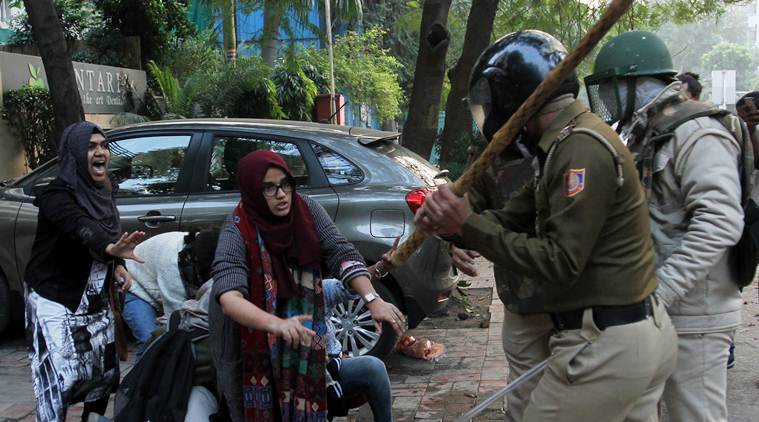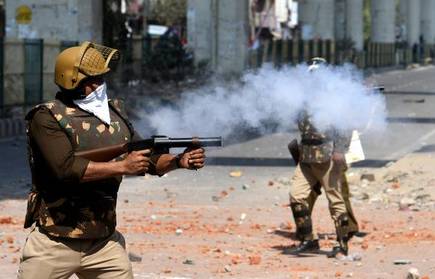Trigger Warning: Police brutality, Custodial violence
The United States last week erupted in nationwide protests over the cold-blooded killing of an unarmed African-American man, at the hands of Minneapolis police on May 25. While racism continues to plague America, this incident shook the society’s conscience, and they have taken to the streets ever since, to protest against racism and police brutality. The footage of the incident went viral, sparking international outrage. The video shows 46-year-old George Floyd being pinned to the ground by a white police officer kneeling on his neck, which caused him to asphyxiate, and subsequently led to his death. The officer has been charged with second degree murder, and the four other officers who stood vigil, have been charged with aiding and abetting to murder.

People across the world condemned racism in the US. India doesn’t have to look further from home, as it has its fair share of George Floyds, more often than not, who go nameless. The 2019 protests against the Centre’s Citizenship Amendment Act and National Register of Citizens intensified this list. While Indians and notable celebrities jumped to call out the perpetrators of racism abroad, their long-drawn silence over the protests in our country was deafening. Due to the platform and masses they command, their refusal to call out blatant injustice and discrimination was a great disservice to the nation’s public.
Police brutality is glaringly rampant in the Indian context, and the last six months are a testament of this.
The study titled Status of Policing in India, 2019 surveyed police officers, questioning them about their tendency to use violence. It revealed that the dominant perception among police in Karnataka, Chattisgarh, Bihar and Nagaland was to justify violence by assuming their role as the ‘punisher’. The police in West Bengal, Odisha, Kerala and Punjab were found to be least likely to use violence. The former group also voiced their preference to employ extra-judicial methods to ‘resolve matters’, where they would punish the criminals rather than go through legal ordeal. The latter on the other hand, preferred judicial trials as opposed to meting out informal ‘justice’.
36% of the police officers admitted to using punishment for minor offences, as an alternative to legal trial. 19% or one in five officers agreed that killing the convicts of heinous crimes was ‘justifiable’ than judicial sentences. An analysis by Scroll found that 50% of Indian citizens approved of police brutality. This has held true on several occasions, where the police have been lauded for reining in miscreants. A recent evidence of this is when the country celebrated the extra-judicial killing, or under the guise of ‘self-defense’ as claimed by the police; where the four rapists, who raped and killed a 27-year-old veterinary doctor in Hyderabad, were shot dead in custody. People’s blood thirst was evident when they heaped praises on the police officer who shot the four, claiming the deliverance of ‘true justice.’
427 people died in police custody last year. Although it might be in the legally grey area, it has rapidly become a socially acceptable norm. The analysis further states that 21% of people fully agreed with police violence, while 29% were inclined towards it. It was also found that the respondents who were aware of the stressful working atmosphere of the police were likely to disregard police brutality. The statement of overworked or understaffed police force has been a cliched argument to win public sympathy.
427 people died in police custody last year. Although it might be in the legally grey area, it has rapidly become a socially acceptable norm. The analysis further states that 21% of people fully agreed with police violence, while 29% were inclined towards it. It was also found that the respondents who were aware of the stressful working atmosphere of the police were likely to disregard police brutality. The statement of overworked or understaffed police force has been a cliched argument to win public sympathy.
Additionally, there is also a dearth of literature that explores the functioning of police outside the judicial or legal purview. Indians have been quick with violence. Beatrice Jauregi’s paper, Beatings, Beacons and Big Men: Police Disempowerment and Delegitimation in India, attributes this to its inherent presence in Indian households. Due to familial hierarchy or kinship, violence has always been used as a means of taming conduct. Thus, the widespread indifference to police brutality might have something to do with the society’s firm belief in ‘cultural correction of misbehaviour’ through violence. This is likely reflected in police behaviour, where they take it upon themselves to correct society’s errors.
- Jamia Incident, December 15, 2019
As the nationwide protests against Centre’s CAA and NRC raged on, the country on December 15, 2019, witnessed an obscene abuse of power, when armed police and paramilitary forces stormed the gates of Delhi’s Jamia Millia Islamia University, to forcibly quell the student protests. The students watched in horror as the agency entrusted with the upkeep of law and order, shelled tear gas, rubber bullets, lathi-charged students and vandalised campus property. Media quoted hospitals saying they tended to students with bullet wounds.

There was video and photographic evidence of the police employing brute force against unarmed protesters and hurling ‘anti-national’ slurs at them. Students were evacuated from the university in a criminal-like manner, with their hands over their heads. This sparked nationwide condemnations and student bodies across India protested against Delhi police’s unwarranted brutality.
Nearly six months later, the Delhi High Court has scheduled a hearing of pleas related to the violence during the Jamia protests, on June 12, 2020. Counsels representing Delhi police have sought the dismissal of pleas, stating that the petitions are an utter abuse of PIL jurisdiction, and the violence was a product of a ‘well-planned attempt by some persons with local support‘.
- Northeast Delhi riots, February 23, 2020
The communal riots of Delhi that claimed 53 lives, was another gory blotch on Delhi’s history that witnessed large scale bloodshed and violence. Out of the 53, two thirds were Muslims, and by mid-March, several from the community remained missing. The perpetrators of violence were pegged to be unruly Hindu mobs, bearing saffron flags, who fatally attacked several Muslim citizens unprovoked.

A viral video made rounds on social media where five men were seen lying on the ground, surrounded by armed policemen who were prodding them to sing the national anthem. One of the five, a 24-year-old named Faizan, a resident of Kardam Puri, later succumbed to his injuries. His family said he was misidentified by the police as one of the protesters when he was coming out of a mosque. Dr. Kishore Kumar, medical director of Lok Nayak Hospital where Faizan was admitted, said he had suffered gunshot wounds.
Also read: Beyond Barricades: Police Violence Against Women In Jamia Protests
The police are said to have registered an FIR following his death, which the family was denied access to. It is unlawful to keep someone in custody without a record. Faizan’s family received no documents regarding his detention or release, furthering police’s culpability. While the higher-ups had initially refused to comment on the incident, Joint Commissioner Alok Kumar was reported informing BBC that a probe has been launched into the incident, and that “action will be taken against whoever was responsible”. This was on March 3, 2020.
Victims recounted their spine-chilling ordeal where the police shoved lathis in their mouths, dragged them on the roads facedown and were subjected to inhuman assaults.
It begs the question, who do we turn to when the police err us?
India’s attitude towards police violence has been retributive rather than preventive. Apart from merely flagging concerns, it is imperative to take policy actions that deconstruct police brutality and curb its normalisation. There is a growing need for a legitimate authority that will monitor police’s exercise and enforcement of laws, if the increasing custodial torture, deaths and rapes are anything to go by.
- Police Violence During Lockdown, April 2020
The national lockdown to counter the impact of Coronavirus pandemic was imposed on March 23, 2020, which immediately came into effect without giving citizens time to chalk out their plans for the next 30 odd days. The country was reeling under the effect of lockdown and the financially vulnerable were scrambling to find economic purchase to tide over the next month.

Merely a week into the lockdown, numerous reports of gruesome brutality at the hands of police surfaced. Since the pre-colonial times, the police’s first act of response is meting out lathi-charge to either punish or disperse crowds. Countless videos surfaced, showing policemen overturning vegetable carts, at a time when a large share of the population was going hungry. They were also seen beating up the hungry and homeless migrant workers who had decided on journeying back to their states on foot.
Across cases, the majority of victims of police brutality have been the socially and economically depressed groups, those whose voices are easily suppressed.
India’s attitude towards police violence has been retributive rather than preventive. Apart from merely flagging concerns, it is imperative to take policy actions that deconstruct police brutality and curb its normalisation. There is a growing need for a legitimate authority that will monitor police’s exercise and enforcement of laws, if the increasing custodial torture, deaths and rapes are anything to go by.
Also read: Police Brutality Against Women: From Soni Sori To Safoora Zargar
To keep abuse of power in check, the Second Administrative Reforms Commission, 2009 had sought the establishment of an independent committee that looks into the complaints of police misconduct. A body that is outside the control of the Centre or State’s political executive, and one with adequate representation from the National Human Rights Council, to check for human rights’ violations.
It is about time we mull over our ethical responsibility as a society and cut back on the glorification of police, in our movies or otherwise.
Pragathi is a Bengaluru-based freelance journalist with a keen interest in gender and political academia. You can find her on Twitter.




